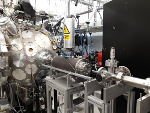| | 13 | - The proposal needs to include a well-thought-out stakeholder engagement plan. Sincethe LhARA programme is multidisciplinary and targets a number of end points the plan needs to be more carefully developed than is typical for a single-topic proposal in the natural sciences. |
| | 14 | - The discussion of the definition of the Stakeholder Plan has begun. One goal is to identify the people or groups who may wishe to be involved in, or to contribute to the project, those that seek to benefit, thise that we need to influence, and those who control resource or influence. The Stakeholder Plan needs to include the development of the PPI activity. A workshop to develop the PPI progranmme is being organised. |
| | 15 | - Among the stakeholders are the UK research councils. These sit under UKRI. Contacts are each of the relevant RCs are to be identified (**action KL:** make initial list of RCs and initiate identification of contacts), |
| | 16 | - The LhARA collaboration has contributions from each of the four UK Nations. The idea of making appropriate contacts in each of the Nations has been agreed. The concept can be extended to regional contacts, perhaps through MPs since the regional development agencies are no longer active. |
| | 17 | - Links with overseas labs need to be developed, including MoUs where approprate. A Collaboration Agreement with CERN is with the legal departments at CERN and STFC. Otehr relevant laboratories also need to be considered. |
| | 18 | - PP highlighted the need to make contact with "decision makers" (Lords and Commons). Need to think about possible topics for written questions. The development of such an activity probable needs to be coordinated. |
| | 19 | - PP asked for input on who the key persons/groups are/will be going forward. In relation to the development of contacts with decision makers, HH commented that this can take time. In considering this, PP emphasised that the LhARA programme is at the early stage of its lifecycle and the need is to get the opportunity and benefits across to the widest audience. |
| | 20 | - TG: Noted the possibility that the "Levelling-up agenda" could be targetted to supoort the develoipment of the concept for the project. PP agreed that this was a good idea and sghould be considered. The idea resonated with HH too. HH commented that the development of the case for the project should also see to exploit the government's ambition to raise teh profile of forefront science in the UK. PP agreed. |
| | 21 | - SG: Pointed out that EPSRC was a key stakeholder as it had funded both the A-SAIL programme and radiobiology projects. |
| | 22 | - PW: Noted the history of the ALIS/4GLS projects in relation to the leveling-up agenda. He noted that the Heseltine review of science in the nortwest. The Heseltine report called for a new project at DL to enhance the scientific activity of the region. The DL campus now has a good industrial research activity but had relatively smaller impact in curiosity-driven science. Building the LhARA case might enhance this too. The Universiry of Liverpool has set up the Heseltine Institute which has produced a report on teh benefits of a new project at DL. PP asked for copies of the reports mentioned (**Action PW:** provide Hesletine and Heseltine Institute reports to PP). |
| | 23 | - NB: Commented that a document had been produced on the benefits that accrued from teh SRS. The document, which was produced after the closure of the SRS, is valuable since it can be used to evaluate the benefit of a scientific infrastructure such as LhARA without being directly a "campaigning document". |
| | 24 | - We discussed the need to make contact with the relevant MPs. As noted above such an activity may need to be coordinated. We didnt set an action, but, **KL:** will try and put together a list of MPs with institutes/entitities in their area who are part of the LhARA collaboration or who may benefit. |
| | 25 | - KK: Emphasised the importance of looking at opportunities across the research councils given the multidisciplinary nature of the activity. She also suggested that ESRC be included in the consideration in view of the societal impacts. |
| | 26 | - TG: Noted that the CASSIM project that was conceived after Diamond was approved at RAL included the development of proton therapy. The history of this initiative was discussed by SG and PW who had been closely involved in the development of the case and PP who had been involved in its peer review. The key issue for LhARA is the need to be clear about the motivation for our programme and to be scienfically and technically robust in its development. |
